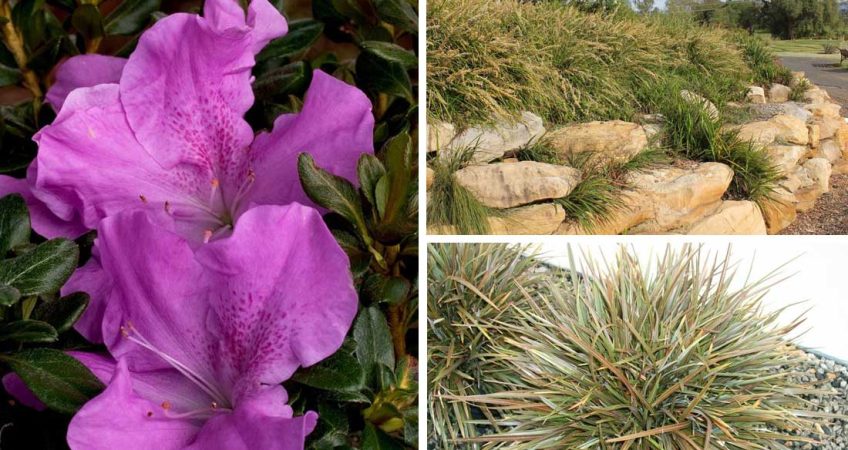Introduction
Are you tired of spending countless hours maintaining your garden, only to see plants struggle or fail? Perhaps you’re specifying plants in a design and wish to save money for yourself or a client on the long-term maintenance of that garden.
In this article, we’ll explore the most low-fuss, functional, and reliable plants that will save you money, time, and effort while ensuring a beautiful garden the whole year round.
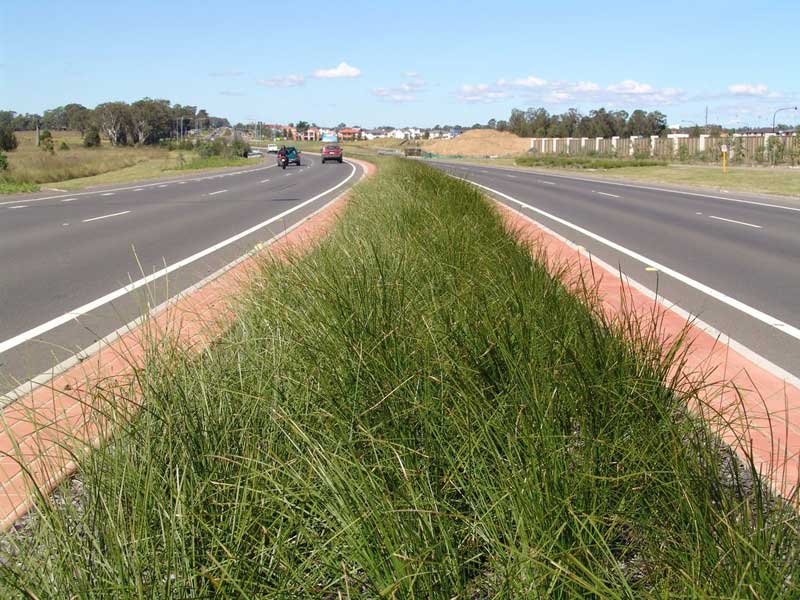
Some plants look amazing, even when they’re in a drought-prone roadside position that’s as hot as an oven. Tanika™ Lomandra longifolia ‘LM300’ PVR. https://ozbreed.co.nz/plant-ranges/strappy-leaf-plants/tanika-lomandra/
Low-Fuss, Functional, and Reliable Plants
Definition
What makes a plant low-fuss, reliable, and functional?
• Low-fuss: These plants have minimal care requirements, making them easy to manage.
• Functional: These plants offer both aesthetic and practical benefits, often being bred for specific purposes in the landscape.
• Reliable: They have a high success rate in various conditions, ensuring they thrive without constant attention.
Practical Tips for Choosing and Caring for Low-Fuss Plants
Research and Planning
Before planting, it’s important to research and select the best plants for your landscape’s conditions and your functional requirements.
• Understanding Your Local Climate: Know your area’s general climate as well as the different microclimates within your garden. This includes recognising areas that receive more sunlight, are shaded, different topographic zones, and areas that have different moisture levels.
• Soil Conditions: Test your soil to understand its composition, pH, and drainage capabilities. Even if it’s just a simple pH test from your local hardware shop and rolling some soil in your hands to feel the texture. This will help you choose plants that are suited to your garden’s specific conditions.
• Light Patterns: Observe the light patterns throughout the day and across seasons. In New Zealand, the sun is slightly further north in the sky due to being in the Southern Hemisphere, shifting further north in winter.
• Mature Size and Growth Habit: Consider how large each plant will grow and its natural shape. Ensure there is enough space for the plants to mature without overcrowding, which can lead to increased maintenance needs. Alternatively, you can over-plant during installation to fill the space, then remove (thin) half the plants as they mature.
Planting and Establishment
Proper planting techniques are essential for the healthy establishment of low-fuss plants.
Step-by-Step Guide on Planting:
1. Preparation: Test the soil for texture, compaction, soil organic matter, etc. Ensure it’s moist, watering the night before if necessary. If you’re installing several plants within a bed, and aren’t retaining any in the area, you can till the entire bed and add organic matter. Especially if the soil is poor to begin with. Place plants in their position, facing the best direction and measure and use string lines if necessary.
2. Digging the Hole: Dig a hole twice as wide and just as deep as the root ball of the plant.
3. Planting: Place the plant in the hole, ensuring the top of the root ball is level with the ground surface. If you haven’t already added organic matter, generously add some to the backfill.
4. Backfilling: Fill the hole with soil, gently firming it around the roots to eliminate air pockets. Avoid compacting soil.
5. Watering: Water thoroughly to help settle the soil and establish good root-to-soil contact.
Initial Care Requirements: Newly planted specimens need extra care during their establishment phase. This includes regular watering, especially during dry periods, and applying mulch to retain moisture and regulate soil temperature.
Long-Term Maintenance
Once established, low-fuss plants require minimal ongoing maintenance, but some regular tasks will ensure they remain healthy and attractive.
Regular Maintenance Tasks:
• Shrubs with Natural Shape: Minimal pruning is needed for shrubs that maintain an attractive form without intervention. You can remove dead, damaged and diseased branches as well as crossing branches (those that rub on each other) as well as competing branches (those that grow straight upward, except for the main leading branch/trunk)
• Topiary and Hedges: Regular trimming is required to maintain the desired shape and density. Once they become overgrown, it can be difficult and time-consuming to get them back in shape
• Strappy Plants: Some, like agapanthus, benefit from deadheading, while others, like lomandra, may do best with a hard pruning every few years.
• Trailing Ground Covers: Shear at the garden border to keep growth in check, or selectively prune longer stems to thin out the plant as it matures for a natural shape.
• Monitoring for Pests and Diseases: Regularly inspect your plants for signs of stress, pests and diseases. Early detection and treatment can prevent minor issues from becoming major problems.
Most Low-Fuss, Functional, and Reliable Plants
Cultivated Varieties
Now that we know what makes a plant low-fuss, functional and reliable, let’s explore some of the best examples that have ever been bred, including strappy-leafed plants and hedges. These plants are cultivated varieties, specifically bred for purpose within the built landscape.
Some plants are tolerant of flooding and drought, others require minimal pruning, and others are designed to solve a specific problem that landscape designers, nursery growers, landscapers and maintenance crews often experience.
Strappy Plants and Groundcovers
Stripy Mist™ Phormium tenax ‘PHOS4’ PVR
Stripy Mist™ Phormium is an ultra-compact NZ flax with attractive minty green foliage mixed with chocolate brown. This cultivar provides year-round colour contrast and remains at a great compact height, making it ideal for various landscaping uses such as mass planting, erosion control, border definition and contrast planting.
Size
• Height: 40 cm
• Width: 40 cm
Low Fuss, Functional & Reliable
• Clumping Habit: Maintains a neat and tidy appearance with minimal maintenance, and does not outgrow its position.
• Versatile Uses: Excellent for mass plantings, low borders, fill-in plants, containers, and patio pots.
• Climate Resilience: Tolerates heavy frost and dry conditions well.
Soil
Stripy Mist™ Phormium tolerates a wide variety of soil types but thrives best in free-draining soil. Plant in a well-mulched garden for optimal growth, using chunky mulch and ensuring the base of the plant is not covered.
Climate (Where It Works in NZ)
This plant is suitable for both the North and South Islands of New Zealand. It adapts well to full sun to part shade positions, maintaining its resilience across different climatic conditions.
Care
- Establishment: Water as required for 8-13 weeks until established.
- Watering: Needs water in summer.
- Mulching: Use chunky mulch, making sure not to cover the base of the plant.
- Fertilising: Apply slow-release fertiliser in spring if needed.
- Pruning: Remove older foliage as required, or cut back to half the height every 2-5 years for best appearance.
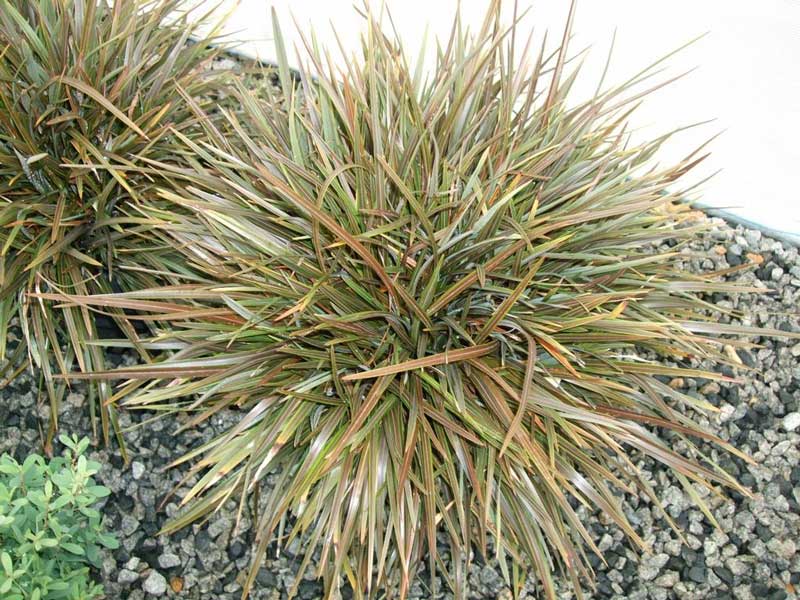
https://ozbreed.co.nz/plant-ranges/strappy-leaf-plants/stripy-mist-phormium/
Sweet Mist™ Phormium tenax ‘PHOS2’ PVR
Sweet Mist™ Phormium is an ultra-compact New Zealand native flax, with stunning bronze foliage. This cultivar is ideal for modern landscape design, offering year-round colour contrast and a compact size that makes it suitable for various settings, including roadside plantings where conditions are harsh and line of sight is crucial.
Size
• Height: 40 cm
• Width: 40 cm
Low Fuss, Functional & Reliable
• Compact Growth: Its low-growing, dense foliage makes it perfect for mass plantings, low borders, fill-in plants, containers, and patio pots.
• Maintains Foliage Colour: Some phormiums are stressed and lose their leaf vibrancy easily, while Sweet Mist and Stripy Mist NX flax leaves remain vibrant.
• Climate Tolerance: Handles frost and moderate dry conditions well.
Soil
Sweet Mist™ Phormium tolerates a wide range of soil types but performs best in free-draining soil. For optimal growth, it should be planted in well-mulched gardens with chunky mulch recommended.
Climate (Where It Works in NZ)
This plant is appropriate for both the North and South Islands of New Zealand. It thrives in full sun to partially shaded positions. In Sydney, it requires a shaded position with irrigation, except in coastal areas where it can handle full sun.
Care
- Establishment: Water as required for 8-13 weeks until established.
- Watering: Needs irrigation during summer, especially in dry conditions.
- Mulching: Use chunky mulch, ensuring the crown or base of the plant is not buried.
- Fertilising: Apply slow-release fertiliser in spring if necessary.
- Pruning: Remove older foliage as needed or cut back to half the height every 5-7 years for the best appearance, though it will look better with more frequent pruning.
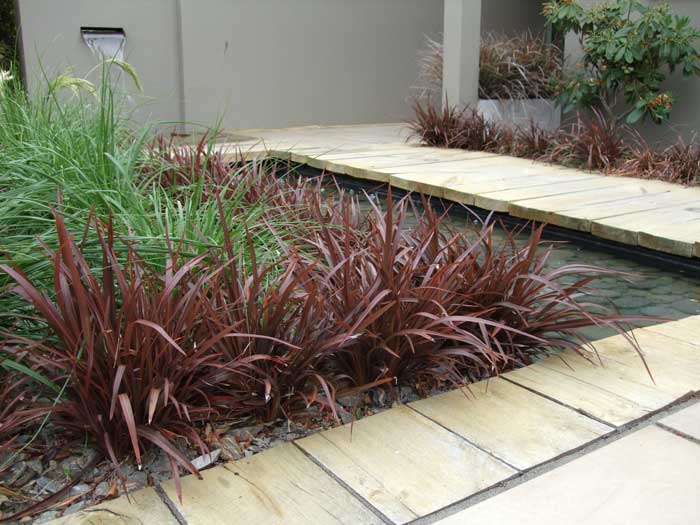
https://ozbreed.co.nz/plant-ranges/strappy-leaf-plants/sweet-mist-phormium/
Little Jess™ Dianella caerulea ‘DCMP01’ PVR
Little Jess™ Dianella is a dwarf, clumping plant with a compact growth habit and short canes that don’t fall over. Because they’re short canes, it’s optional whether they require dead-heading or not. This Australian flax plant produces masses of purple flowers from September to November and is highly drought-tolerant.
Size
• Height: 40 cm
• Width: 40 cm
Low Fuss, Functional & Reliable
• Drought Tolerance: Little Jess™ Dianella is more drought-tolerant than other Dianella caerulea varieties, including Breeze™ Dianella.
• Minimal Trimming: This cultivar only needs trimming around every 8 years. For optimal appearance, pruning every 2-3 years is recommended for manicured gardens, while roadside plantings may need attention every 4-8 years.
• Optional Deadheading: Dianellas usually have tall flower canes that can look unsightly after the flowers and berries fall off. This cultivar has shorter canes that stay upright, with most of the length hidden beneath the foliage.
Soil
Little Jess™ Dianella suits a wide variety of soils but should avoid very poor soils. It thrives best when planted in a well-mulched garden with chunky mulch.
Climate (Where It Works in NZ)
This plant is suitable for both the North and South Islands of New Zealand. It tolerates full sun to moderate and heavy shade, as well as drought, humidity, and frost.
Care
- Establishment: Water as required for 8-13 weeks until established.
- Mulching: Ensure the crown or base of the plant is not below soil or mulch level.
- Fertilising: Apply slow-release fertiliser in spring if needed.
- Trimming: Cut back half the height every 2-8 years, depending on the location and desired appearance.

https://ozbreed.co.nz/plant-ranges/strappy-leaf-plants/little-jess-dianella/
Tasred™ Dianella tasmanica ‘TR20’ PVR
Tasred™ Dianella is a tough, adaptable, and reliable landscape plant with a dense, tidy appearance. It features wide green leaves that often develop red bases in cool climates and reddish tinges in frost-prone areas. This cultivar also produces attractive large purple berries in spring and summer, and can tolerate full sun to heavy shade.
Size
• Height: 45 cm
• Width: 40-50 cm
Low Fuss, Functional & Reliable
• Drought and Frost Tolerance: Tasred™ Dianella is highly resilient, tolerating both drought and frost conditions.
• Shade Tolerance: It can be hard to find exciting plants for heavy shade. This is an excellent plant for those shady positions, while also thriving in full sun.
• Erosion Control: The plant is excellent for erosion control, strengthening the soil significantly.
• Minimal Pruning: Trim older leaves as needed and cut back halfway every 3-7 years to encourage new growth, depending on aesthetic preferences and requirements.
• Versatility: Serves as a great alternative to Xanadu, Liriope and Phormium and suits various landscaping uses including mass plantings, low light gardens, Japanese-style gardens, and accent planting.
Soil
Tasred™ Dianella thrives in sandy, sandy loam, and clay-dominant soils but should avoid very poor soils. It benefits from being planted in well-mulched gardens, with chunky mulch recommended.
Climate (Where It Works in NZ)
This cultivar is suitable for both the North and South Islands of New Zealand. It performs well in full sun to heavy shade and can handle a range of temperatures, from frost to heat.
Care
- Establishment: Water as required for 8-13 weeks until established.
- Mulching: Ensure the crown or base of the plant is not below soil or mulch level to prevent rot.
- Fertilising: Apply slow-release fertiliser in spring if needed.
- Trimming: Trim older leaves as required and cut back halfway every 3-7 years to promote new growth and maintain a neat appearance.

https://ozbreed.co.nz/plant-ranges/strappy-leaf-plants/tasred-dianella/
Evergreen Baby™ Lomandra longifolia subsp. exilis ‘LM600’ PVR
Evergreen Baby™ Lomandra is a compact, fine-leaved, and evergreen strappy leaf plant that can tolerate both periodic flooding and drought. It produces abundant golden flowers in spring and is sterile. This cultivar is about half the size of the popular Tanika™ Lomandra and is perfect as an erosion-controlling ground cover, border plant, or a roadside plant that doesn’t obstruct line of sight. The image below shows this cultivar thriving beside other plants dying from flooded conditions and phytophthora infection.
Size
• Height: 40-45 cm
• Width: 40 cm
Low Fuss, Functional & Reliable
• Drought and Wet Feet Tolerant: Evergreen Baby™ Lomandra is highly tolerant of both drought and periodic wet feet, making it extremely reliable in various environmental conditions. This plant can be installed into depressed areas that suffer from drainage issues, on slopes to control erosion, and in gardens that lack irrigation. The photo below shows this cultivar thriving nearby others that failed the flooding tests we put them through.
• Phytophthora Resistant: This cultivar thrives beside other lomandras succumbing to phytophthora in wet soils.
• Compact Growth: It can grow in smaller spaces where other lomandras need constant pruning to prevent them overtaking pathways, etc. Pruning is needed only every 3-5 years depending on aesthetic preferences.
Soil
Evergreen Baby™ Lomandra thrives in a range of soil types, from sandy loam to heavy clay. It isn’t fussy about soil conditions, but a well-mulched gardens with chunky mulch recommended for best results.
Climate (Where It Works in NZ)
This plant is suitable for both the North and South Islands of New Zealand. It performs well in full sun to part shade positions and can tolerate frost, drought, and periodic wet feet.
Care
- Establishment: Water as required for 8-13 weeks until established.
- Mulching: Ensure the crown or base of the plant is not below soil or mulch level to prevent rot.
- Fertilising: Apply slow-release fertiliser in spring if needed.
- Trimming: Cut back 15 cm above the ground every 3-5 years for best performance, depending on your requirements.
- Watering: Occasional watering may be required during dry periods. Tough in flooded conditions.
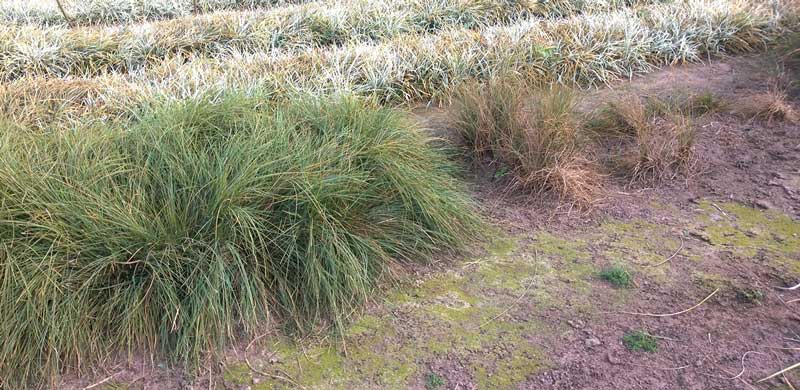
https://ozbreed.co.nz/plant-ranges/strappy-leaf-plants/evergreen-baby-lomandra/
Lomandra longifolia ‘KATRINUS DELUXE’ PVR
Katrinus Deluxe™ is an improved form of the Katrinus Lomandra, featuring bigger and better flowers, finer leaves, and a more dense and compact form. This clean-growing, uniform plant produces masses of stunning yellow flowers and is highly effective for erosion control.
Size
• Height: 70 cm
• Width: 70 cm
Low Fuss, Functional & Reliable
• Drought and Frost Tolerance: Katrinus Deluxe™ is highly drought-tolerant, thriving on natural rainfall with occasional top-up watering needed only in extreme drought conditions. It also tolerates frost well.
• Optional Pruning: The plant’s clumping growth habit requires minimal maintenance, with a hard prune being recommended to freshen the plants up roughly every 7 years.
• Erosion Control: Its robust root system contributes significantly to soil stabilisation.
Soil
Katrinus Deluxe™ suits a wide range of soils from sandy to clay. For optimal growth, it should be planted in a well-mulched garden with chunky mulch recommended.
Climate (Where It Works in NZ)
This cultivar is suitable for both the North and South Islands of New Zealand. It performs well in full sun to moderate shade and can handle a range of climatic conditions including frost and drought.
Care
- Establishment: Water as required for 8-13 weeks until established.
- Mulching: Ensure the crown or base of the plant is not below soil or mulch level to prevent rot.
- Fertilising: Apply slow-release fertiliser in spring if needed.
- Trimming: Cut back to 20 cm or half the height every 7 years if required. Avoid trimming during drought conditions or in the middle of summer.
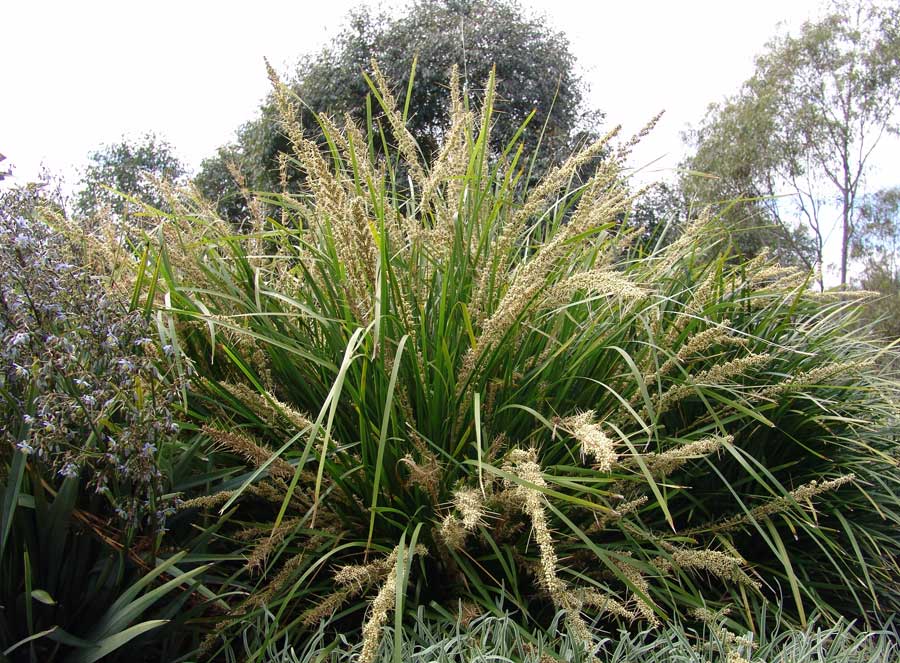
https://ozbreed.co.nz/plant-ranges/strappy-leaf-plants/katrinus-deluxe-lomandra/
Amethyst™ Liriope muscari
Amethyst™ Liriope is a semi-compact strappy-leafed plant with stunning, long-lasting deep purple flowers that sit high above the foliage. Unlike most Liriopes, this cultivar has excellent foliage form, reliably producing dark green clumps. Amethyst™ Liriope is also remarkable for its superior flower height and foliage compared to other Liriope varieties. This liriope is not invasive like some other varieties.
Size
• Height: 40 cm
• Width: 40 cm
Low Fuss, Functional & Reliable
• Climate Adaptability: Grows well throughout New Zealand, including in humid northern regions and bitterly cold areas. It can also tolerate full sun to heavy shade.
• Bounces Back: In colder climates, trimming the foliage back each year in late winter helps fresh new shoots emerge, providing a refreshed look by spring or summer. This is optional, and can be performed after any kind of damage including slug damage, physical damage from foot traffic, etc.
• Minimal Care Needs: While annual pruning is recommended for optimal appearance, new growth will cover any discoloured leaves even if pruning is not performed.
• Versatility: Ideal for mass plantings, rockeries, flower gardens, and as specimen plants. Good for spots that receive heavy shade for part of the year, and more sunlight in another part of the year.
Soil
Amethyst™ Liriope is suited to a wide variety of soil types. For best results, it should be planted in a well-mulched garden, with chunky mulch recommended.
Climate (Where It Works in NZ)
This plant is highly adaptable and performs well in both the North and South Islands of New Zealand. It tolerates full sun to moderately heavy shade, as well as frost, drought, and humidity.
Care
- Establishment: Water as required for 8-13 weeks until established.
- Mulching: Ensure the crown or base of the plant is not below soil or mulch level to prevent rot.
- Fertilising: Apply slow-release fertiliser in spring if needed.
- Trimming: Cut back to the ground annually for the best appearance, though new growth will naturally dominate by spring or summer if not trimmed.
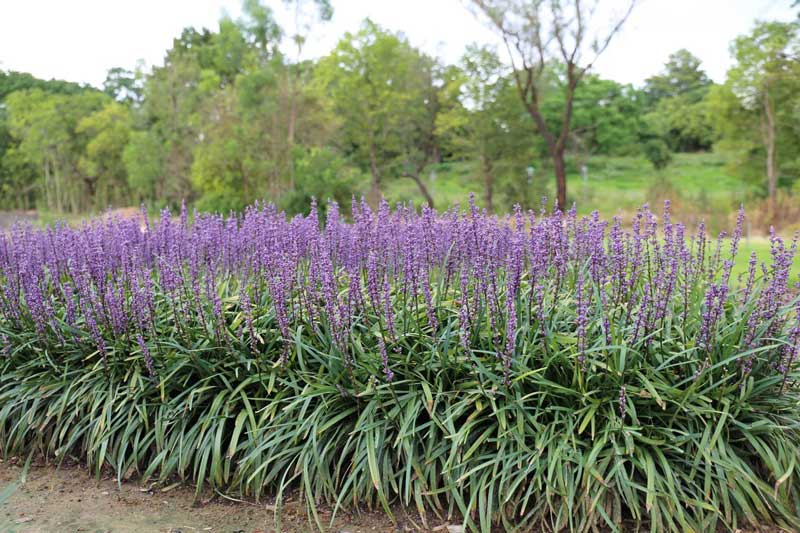
https://ozbreed.co.nz/plant-ranges/strappy-leaf-plants/amethyst-liriope-muscari/
Just Right™ Liriope muscari
Just Right™ Liriope is a compact, uniform, and evergreen plant ideal for landscapes. It serves as an excellent alternative to the Evergreen Giant due to its superior foliage, reduced burn in frost and sun, and better tolerance to wet feet. This cultivar rarely, if ever, produces viable seeds, making it a safer choice for planting.
Size
• Height: 50 cm
• Width: 50 cm
Low Fuss, Functional & Reliable
• Evergreen Foliage: Maintains a consistent height and lush appearance throughout the year.
• Climate Robustness: Burns less in frost and sun compared to other varieties, and has high tolerance for both drought and wet feet conditions.
• Minimal Maintenance: Optional trimming of older leaves only as needed and cutting back every 4-6 years for best appearance, although more frequent pruning will enhance its look.
Soil
Just Right™ Liriope thrives in a range of soil types from sandy to clay. It performs best when planted in well-mulched gardens with chunky mulch recommended.
Climate (Where It Works in NZ)
This plant is suitable for various regions across both the North and South Islands of New Zealand. It adapts well to full sun and light to heavy shade, tolerating a broad spectrum of climatic conditions including heat and frost.
Care
- Establishment: Water as required for 8-13 weeks until established.
- Mulching: Ensure the crown or base of the plant is not covered with soil or mulch to prevent rot.
- Fertilising: Apply slow-release fertiliser in spring if needed.
- Trimming: Trim older leaves as required and cut back every 4-6 years for optimal appearance, with more frequent pruning recommended for enhanced aesthetics.
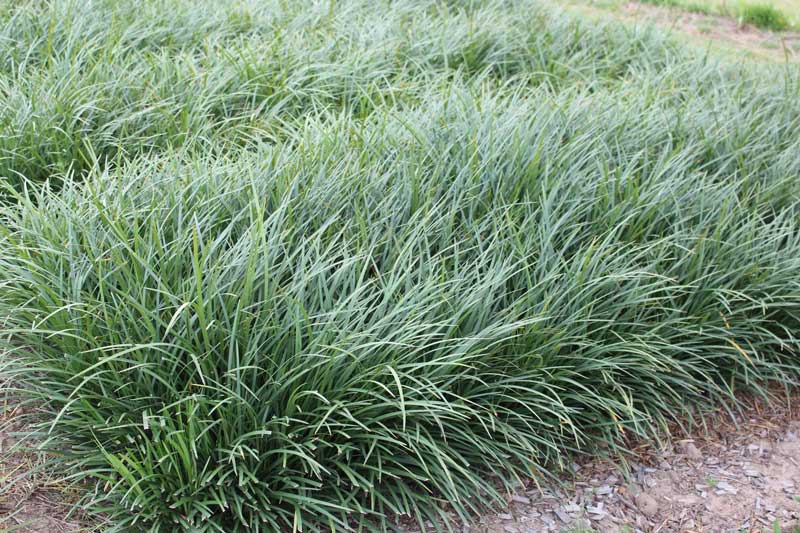
https://ozbreed.co.nz/plant-ranges/strappy-leaf-plants/just-right-liriope/
Shrubs, Screens and Hedges
Grey Box™ Westringia ‘WES04’ PVR
Grey Box™ Westringia is a compact, drought-tolerant shrub that offers excellent colour contrast with its grey foliage and white flowers, which bloom from September to May. This plant is versatile, suitable for use as a hedge or left unpruned in its natural ball shape. It serves as a great drought-tolerant alternative to the English Box, which can also tolerate wet feet.
Size
• Height: 30-45 cm
• Width: 30-45 cm
Low Fuss, Functional & Reliable
• Compact Form: Extremely compact growth habit that maintains a tidy appearance, whether pruned or left natural.
• Drought, Flood and Frost Tolerance: Performs well in drought conditions, flooding and can tolerate frost. This plant can be used in bioswales and rain gardens.
• Functional: Ideal for low hedges, topiary, borders, containers, and mass plantings.
Soil
Grey Box™ Westringia thrives in most soil types. For optimal growth, plant in a well-mulched garden using chunky mulch.
Climate (Where It Works in NZ)
This plant is suitable for both the North and South Islands of New Zealand. It adapts well to full sun to light shade positions.
Care
- Establishment: Water as required for 8-13 weeks until established.
- Mulching: Plant in a well-mulched garden (chunky mulch recommended).
- Fertilising: Use slow-release fertiliser in spring if necessary.
- Pruning: Leave unpruned for a natural ball shape or prune to shape 1-3 times a year after flowering, depending on the desired tidiness.
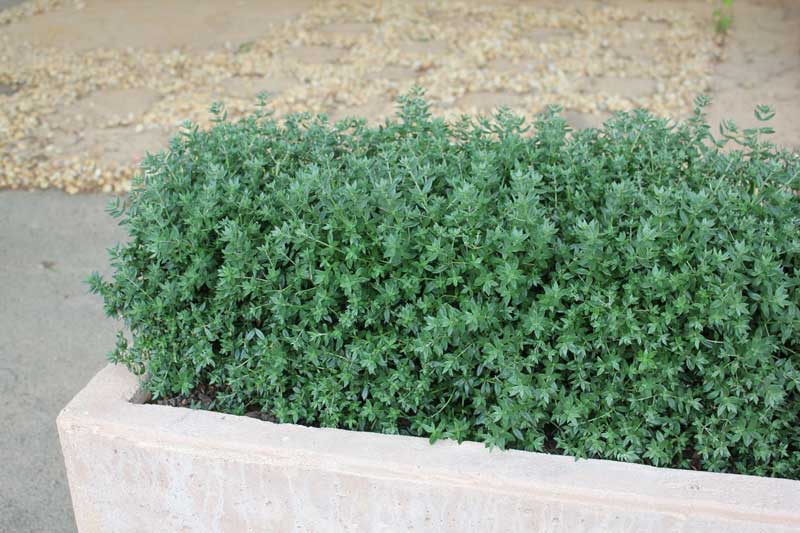
https://ozbreed.co.nz/plant-ranges/shrubs-and-ground-covers/grey-box-westringia/
Mundi™ Westringia fruticosa ‘WES05’ PVR
Mundi™ Westringia is a robust and attractive ground cover shrub with masses of white flowers. It maintains a tidy form without pruning but can also be shaped into low-growing architectural forms. It’s a buffer plant that’s appropriate for rain gardens and bioswales. This cultivar is ideal for cottage gardens, tough roadside environments or any setting requiring minimal maintenance and line of sight.
Size
• Height: 40-50 cm
• Width: 1.5 m
Low Fuss, Functional & Reliable
• Minimal Pruning: Can be left unpruned while maintaining a neat appearance, or pruned to shape 1-3 times per year after flowering for a tidier look.
• Functional: Perfect for lower-maintenance topiary, mass plantings and low-maintenance gardens, providing excellent ground cover.
• Durability: Tolerates cold, flooded and drought conditions well, making it suitable for various challenging environments.
Soil
Mundi™ Westringia thrives in sandy to well-drained clay soils. Plant in a well-mulched garden using chunky mulch for best results.
Climate (Where It Works in NZ)
This plant is suitable for both the North and South Islands of New Zealand. It performs well in full sun to part shade positions.
Care
- Establishment: Water as required for 8-13 weeks until established.
- Mulching: Ensure the garden is well-mulched with chunky mulch.
- Fertilising: Apply slow-release fertiliser in spring if necessary.
- Pruning: Prune to shape 1-3 times a year after flowering, or leave unpruned for a natural shape, adjusting based on desired tidiness.
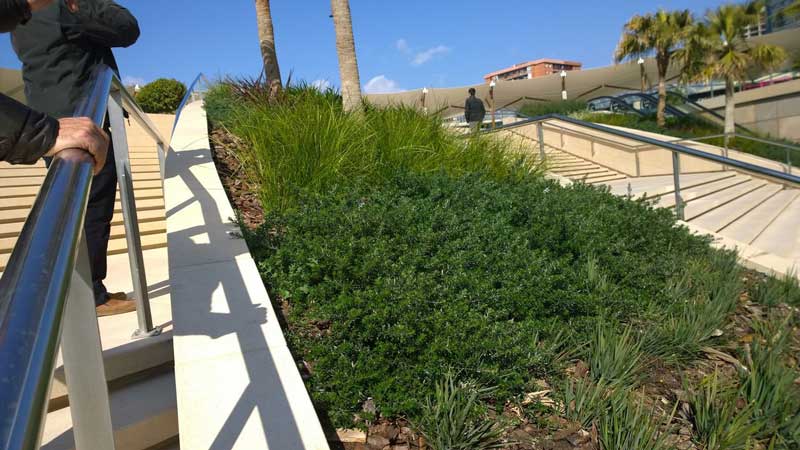
https://ozbreed.co.nz/plant-ranges/shrubs-and-ground-covers/mundi-westringia/
Green John™ Callistemon viminalis ‘LJ23’ PVR
Green John™ Callistemon is a versatile and robust shrub with light green new growth foliage. Easier to grow and quicker to establish than Little John, though slightly slower growing than Better John™ Callistemon, this plant features small red flowers that bloom from mid-spring to late spring, adding a delightful burst of colour.
Size
• Height: 60 cm – 1 m
• Width: 60 cm
Low Fuss, Functional & Reliable
• Growth Rate: Faster to establish than Little John but slower growing than Better John™.
• Buffer Plant: This plant is tolerant of flooding and drought, making it perfect for areas that periodically dry out and flood like depressed areas, bioswales and rain gardens.
• Versatility: Suitable for specimen planting or as a contrasting element in gardens.
Soil
Green John™ Callistemon thrives in sandy to heavy clay soils, and tolerates dry and wet soils.
Climate (Where It Works in NZ)
This plant is suitable for both the North and South Islands of New Zealand. It adapts well to full sun to part shade positions and tolerates drought and cold conditions effectively.
Care
- Establishment: Water as required for 8-13 weeks until established.
- Mulching: Use chunky mulch to maintain moisture and suppress weeds.
- Fertilising: Apply slow-release fertiliser in spring if necessary.
- Pruning: Prune every 3-4 years for a natural shape, or every 2 years for a tidy hedge.
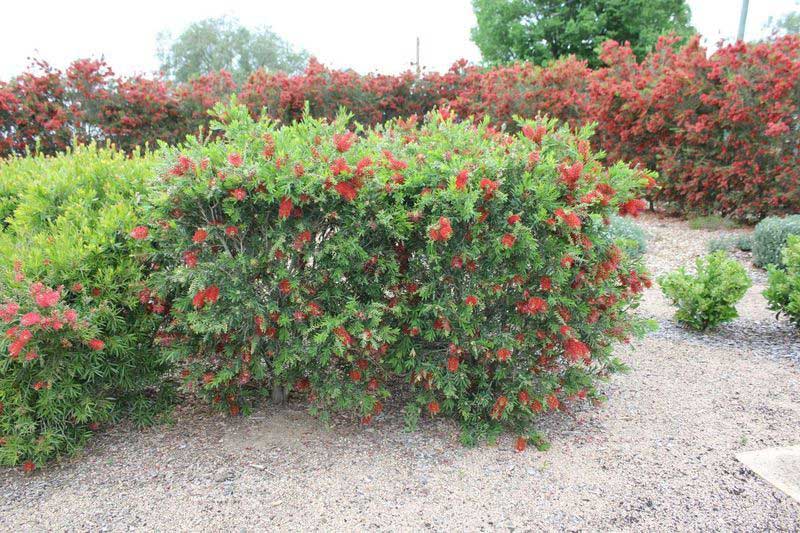
https://ozbreed.co.nz/plant-ranges/shrubs-and-ground-covers/green-john-callistemon/
Slim™ Callistemon viminalis CV01′ PVR
Slim™ Callistemon is another Australian native plant with a tall, narrow growth habit, perfect for tight spaces and along fencelines. It produces masses of flower buds that open to classic bottlebrush flowers throughout spring, summer, and autumn. This cultivar is highly resistant to Myrtle Rust and phytophthora and has been tested to withstand temperatures as low as -6 degrees Celsius without leaf burn.
Size
• Height: 3 m
• Width: 1.3 m
Low Fuss, Functional & Reliable
• Columnar Growth Habit: Ideal for tight planting areas and fencelines due to its narrow, upright form.
• Low Pruning Needs: Because it naturally grows in a columnar shape, it can provide a screen in spaces that would require constant pruning if a wider cultivar were used.
• Versatile Uses: Perfect for use as a screen, hedge, or feature plant in confined spaces.
• Resilience: Highly resistant to myrtle rust and phytophthora as well as tolerant of drought, flood and frost conditions.
Soil
Slim™ Callistemon suits most soil types. For best results, plant in a well-mulched garden using chunky mulch.
Climate (Where It Works in NZ)
This plant is suitable for both the North and South Islands of New Zealand. It performs well in full sun to part shade positions.
Care
- Establishment: Water as required for 8-13 weeks until established.
- Mulching: Use chunky mulch to maintain moisture and suppress weeds.
- Fertilising: Apply slow-release fertiliser in spring if necessary.
- Pruning: Prune to shape 1-3 times a year after flowering depending on your requirements. More frequent pruning will result in a tidier hedge or shape.

https://ozbreed.co.nz/plant-ranges/shrubs-and-ground-covers/slim-callistemon/
Blush™ Nandina domestica ‘AKA’ PVR
Blush™ Nandina is a revolutionary medium-sized dwarf Nandina that features striking red foliage in winter, spring, and autumn. It’s 20% smaller than Nandina domestica ‘Nana’, making it perfect for fences, borders, or low hedging.
Size
• Height: 60-70 cm
• Width: 60-70 cm
Low Fuss, Functional & Reliable
• Seasonal Colour: Produces red new growth in spring and autumn, with a vivid red colour in winter.
• Compact Growth: 20% smaller than Nandina domestica ‘Nana’, ideal for low hedges, borders, or as a compact shrub that doesn’t require pruning.
• Non-invasive: Will not spread from seed, making it a safe choice around bushland.
Soil
Blush™ Nandina tolerates a variety of soil types, from free-draining to heavy clay soils. For optimal growth, plant in well-mulched gardens using chunky mulch.
Climate (Where It Works in NZ)
This plant is suitable for both the North and South Islands of New Zealand. It thrives in full sun to moderate shade positions and is tolerant of both drought and frost conditions.
Care
- Establishment: Water as required for 8-13 weeks until established.
- Mulching: Use chunky mulch to maintain moisture and suppress weeds.
- Fertilising: Apply slow-release fertiliser in spring if necessary.
- Pruning: Can be left unpruned or pruned to shape every 3 years if required.

https://ozbreed.co.nz/plant-ranges/shrubs-and-ground-covers/blush-nandina/
Obsession™ Nandina domestica ‘SEIKA’ PVR
Obsession™ Nandina is an improved selection of the popular dwarf Nandina ‘Gulf Stream’. It features bright red new growth throughout spring, autumn, and summer, with a full flush of red in winter. The plant has a dense, upright growth habit, providing interesting foliage shapes and colours..
Size
• Height: 60-70 cm
• Width: 60-70 cm
Low Fuss, Functional & Reliable
• Year-Round Colour: Exhibits vibrant red new growth for most of the year.
• Dense Growth: Maintains a compact and upright form with optional pruning.
• Planting Density: Ideal density is 3-6 plants per square metre or 2-3 plants per linear metre.
• Versatility: Suitable for use as a low hedge, shrub, or border plant.
Soil
Obsession™ Nandina thrives in well-drained soils. For optimal growth, plant in a well-mulched garden using chunky mulch.
Climate (Where It Works in NZ)
This plant is suitable for both the North and South Islands of New Zealand. It performs well in full sun to moderate shade positions and tolerates cold and drought conditions effectively.
Care
- Establishment: Water as required for 8-13 weeks until established.
- Mulching: Use chunky mulch to maintain moisture and suppress weeds.
- Fertilising: Apply slow-release fertiliser in spring if necessary.
- Pruning: Prune every 2-3 years if required to maintain shape and size.
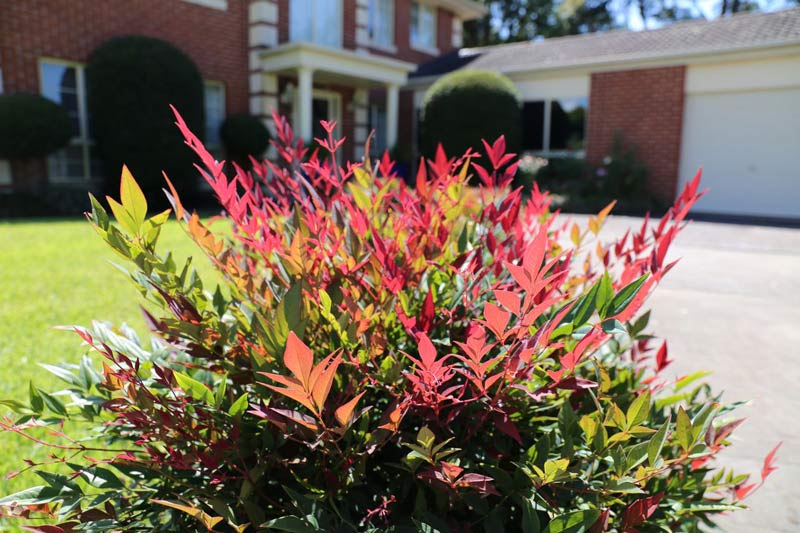
https://ozbreed.co.nz/plant-ranges/shrubs-and-ground-covers/obsession-nandina/
Autumn Ivory™ Rhododendron hybrid ‘ROBLEV’
Autumn Ivory™ Azalea is a compact, dwarf azalea with heavy flowering in autumn and spring, and regular blooms throughout summer. It produces bright white flowers that attract butterflies and adds a touch of elegance to any garden.
Size
• Height: 80 cm
• Width: 95 cm
Low Fuss, Functional & Reliable
• Extended Blooming: Features bright white flowers that bloom heavily in autumn and spring, with additional blooms in summer.
• Compact Growth: The dwarf habit makes it ideal for gardens with limited space, with pruning optional.
• Functional: Suitable for short hedges, mass planting, garden beds, borders, and container planting.
• Planting Density: Optimal density is 1-3 plants per square metre or 1-2 plants per linear metre.
Soil
Autumn Ivory™ Azalea prefers well-drained soils. For best results, plant in a garden with chunky mulch, ensuring the entire stem is exposed to the air, and the entire root ball is submerged beneath soil and mulch.
Climate (Where It Works in NZ)
This plant is suitable for both the North and South Islands of New Zealand. It thrives in positions ranging from full sun to part shade and tolerates frost and moderate drought conditions (becoming more drought-tolerant as it matures).
Care
- Establishment: Water well for the first year to help the plant establish and gradually reduce irrigation to develop drought tolerance.
- Watering: Top up water during dry periods.
- Mulching: Use chunky mulch to maintain soil moisture and suppress weeds.
- Fertilising: Apply slow-release fertiliser in spring if necessary.
- Pruning: Prune after spring flowering to maintain shape and encourage further blooms.
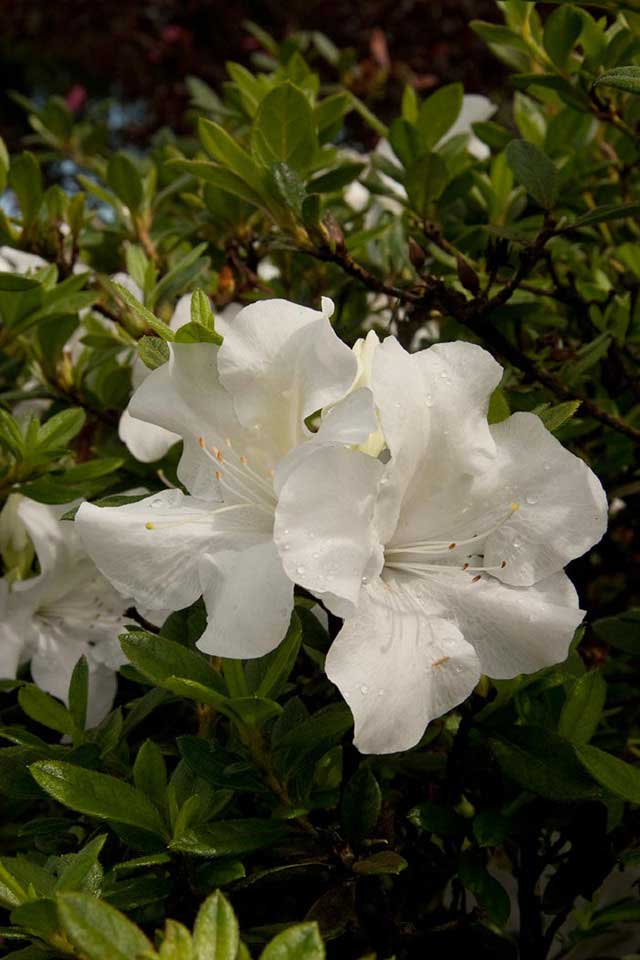
https://ozbreed.co.nz/plant-ranges/encore-azaleas/autumn-ivory/
Autumn Lilac™ Rhododendron hybrid
Autumn Lilac™ Azalea is a compact azalea with a rounded growth habit, featuring shiny green foliage and single lavender blooms accented with darker purple freckles. The flowers are approximately 50mm in diameter and attract butterflies. This variety is known for heavy flowering in autumn and spring, with repeat blooms in summer.
Size
• Height: 95 cm
• Width: 1 m
Low Fuss, Functional & Reliable
• Extended Blooming: Provides lavender blooms throughout autumn, spring, and summer.
• Compact Growth: Ideal for smaller gardens, mass planting, and borders.
• Resilience: Tolerates frost and becomes more drought-tolerant as it matures.
Soil
Autumn Lilac™ Azalea prefers well-drained soils. For best results, plant in a well-mulched garden using chunky mulch, ensuring the root ball is slightly above soil level to prevent waterlogging.
Climate (Where It Works in NZ)
This plant is suitable for both the North and South Islands of New Zealand. It performs well in full sun to part shade positions and can tolerate both frost and moderate drought conditions.
Care
- Establishment: Water well for the first year to help the plant establish and develop drought tolerance.
- Watering: Top up water during dry periods.
- Mulching: Use chunky mulch to maintain soil moisture and suppress weeds.
- Fertilising: Apply slow-release fertiliser in spring if necessary.
- Pruning: Prune after spring flowering to maintain shape and encourage further blooms.
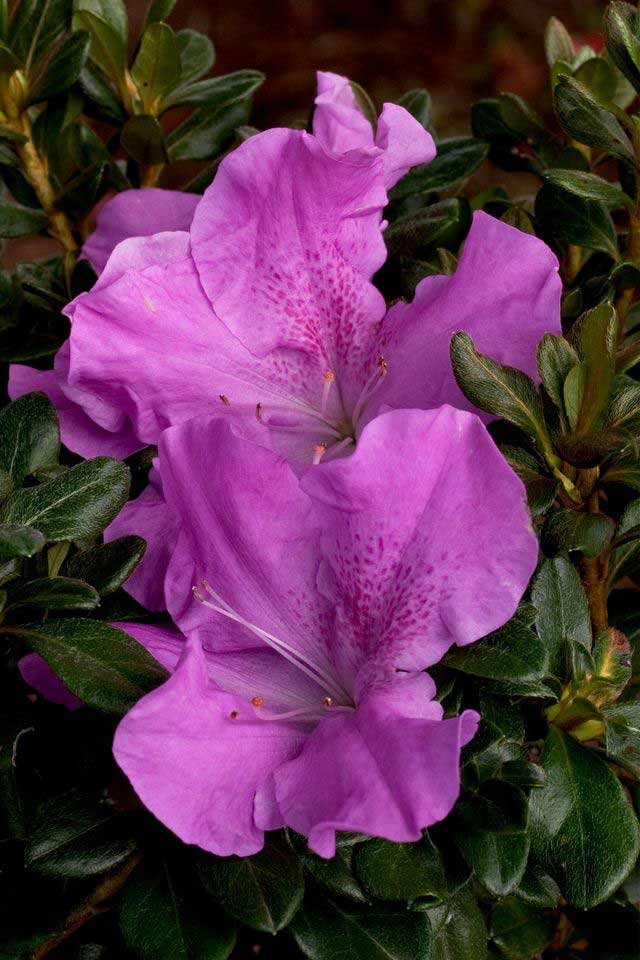
https://ozbreed.co.nz/plant-ranges/encore-azaleas/autumn-lilac/
Conclusion
Choosing low-fuss, reliable, and functional plants can transform your garden into a beautiful, sustainable, and easy-to-maintain space. By understanding your garden’s unique conditions and selecting plants accordingly, you can enjoy a thriving garden with minimal effort. Start incorporating these plants into your landscape today to save time, effort, and money while enjoying a lush, vibrant garden all year round.

